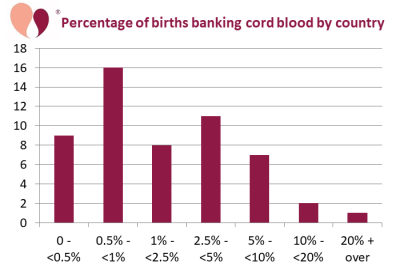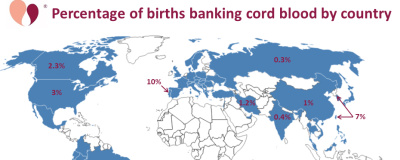Вы здесь
Percentage of births banking cord blood by country
Ever since the invention of cord blood banks, people that track public health behavior have wanted to know what fraction of newborns have their cord blood preserved, and how this varies by country. We have compiled the percentage (%) of births that store cord blood, both public and private storage combined, for 54 countries and territories. The % of births banking cord blood is defined as the number of units banked in the most recent year with data, divided by the number of births in the same year, and converted from a fraction to a percentage (multiply by 100).
The data are presented as an active map on a separate web page, displaying both the cord blood banking % and the number of births in each country or territory. Most of the data are from 2018, but a few represent 2019 extrapolations. The family cord blood banking data in this map is based on interviews with cord blood bankers. The existence or lack of data for a particular country reflects our ability to get bankers to answer our survey. We also looked up birth rates compiled by Wikipedia, and supplemented them with media reports about changing birth rates in specific countries. An excel file of the data is available upon request.
 Here we present a histogram of the % banking in 54 countries and territories. For the world as a whole,the first data bin from 0 to under 0.5% banking is vastly under-reported, since we usually did not attempt to survey regions with very little banking.
Here we present a histogram of the % banking in 54 countries and territories. For the world as a whole,the first data bin from 0 to under 0.5% banking is vastly under-reported, since we usually did not attempt to survey regions with very little banking.
It was crucial to look up an accurate number of births for each region. In most developed nations, the number of births is dropping by 1-3% per year. We found that using a birthrate extrapolated from a previous year could reduce the % births banking cord blood by 0.1%, which is significant when the % is below 1% for 27 of the 54 countries and territories included in this graph. One example is Japan, where the birth rate has been declining significantly for decades due to societal changes. Another example is Puerto Rico (which is actually a United Sates territory and not a country), which has experienced a massive population exodus since Hurricane Maria in 2017. Several countries in Eastern Europe are also experiencing sharp population declines due to an exodus of young people.
An unpleasant secret of the cord blood industry, as we enter the 2020s decade, is that many public banks in many countries have quietly stopped collecting cord blood donations, and are only managing existing inventory. The use of cord blood for stem cell transplants has fallen worldwide, as many oncologists now favor haplo-identical bone marrow transplants. The number of cord blood transplants per year reported by the World Marrow Donor Association (WMDA) fell from 4150 in 2012 to 2783 in 2018. The number of new cord blood donations added to the WMDA public inventory was 69 thousand in 2012, but only 26 thousand in 2018. For example, WMDA reports that 615 public donations were banked in France during the year 2018, which divided by 758 thousand births yields a banking rate of 0.08%.
Yet, cord blood donations are higher than suspected in some countries, often due to novel business models for public banking. The highest banking % in this map is 30% in Singapore. It has long been rumored that 20% of births in Singapore store cord blood in family banks, presumably funded by the baby bonus that the government pays to new parents. In addition, the public Singapore Cord Blood Bank has substantially increased their donations by offering parents a “community banking” option which combines private and public banking. Another surprising case is Puerto Rico, where banking covers about 9.5% of births, due to an active network of obstetricians that collect donations of afterbirth blood and tissues.
 A story that we hear from many cord blood bankers around the world, is that while the banking % may be low for their country as a whole, it is a factor of 2-3 times higher in major metropolitan areas. On top of that, within metropolitan areas the banking % can be 2-3 times higher in specific hospitals where the banks have partnerships. In those countries that have a public health system, but parents in the economic elite pay for private care, the family cord blood banking is coming entirely from private hospitals, and again the banking % in those hospitals is significantly higher than the average.
A story that we hear from many cord blood bankers around the world, is that while the banking % may be low for their country as a whole, it is a factor of 2-3 times higher in major metropolitan areas. On top of that, within metropolitan areas the banking % can be 2-3 times higher in specific hospitals where the banks have partnerships. In those countries that have a public health system, but parents in the economic elite pay for private care, the family cord blood banking is coming entirely from private hospitals, and again the banking % in those hospitals is significantly higher than the average.
This data leads to a couple of clear conclusions. One, despite challenges facing the cord blood industry, the practice of cord blood banking is continuing to thrive in countries and territories around the world. By combining the banking rates with the birth rates, we calculate that the worldwide cord blood inventory is increasing by over 600 thousand per year, which is consistent with the growth we have reported for the Top 10 Cord Blood Banks. Second, in most countries and territories the banking penetration of the birth population remains very low and there is substantial room for growth.


